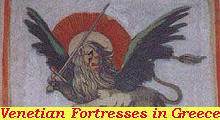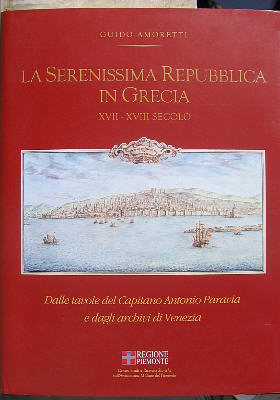

What's New!
Detailed Sitemap
All images © by Roberto Piperno, owner of the domain. Write to romapip@quipo.it. Text edited by Rosamie Moore.
|
 seen by an XVIIIth century traveller seen by an XVIIIth century traveller
An Italian institution involved in studying and researching military architecture (Centro Studi e Ricerche Storiche sull'Architettura Militare del Piemonte) recently published
a book (La Serenissima Repubblica in Grecia) on the Venetian Fortresses in Greece.
It is a book written by two men who never met each other, but who
both shared a strong interest in the memories of the Venetian rule in Greece:
Capt. Antonio Paravia was born in Corf¨ in 1754: he became a cadet in 1769 and in 1785-86 he took part in the
last campaign of the Venetian Navy against the corsairs of Tunisia who often attacked the Venetian merchant ships.
His military career ended abruptly in 1797 when Napoleon and the Austrian Empire put
an end to the history of the Most Serene Republic. Capt. Paravia spent the rest of his life (he passed away in 1828) writing a history of Venice from 1754 to 1797: six books for a total of 4200 pages which he never published and which are kept by Museo Correr in Venice:
he also left to his nephew Pier Alessandro (a professor at the University of Turin) a collection of 174 drawings and aquarelles portraying the Venetian fortresses in Greece: this collection
was bequeathed to the Royal Military Academy of Turin.
Gen. Guido Amoretti was born in Turin in 1920: between 1941 and 1943 as a young second lieutenant of the Italian Army in Greece
he sojourned in many former Venetian fortresses: after having been imprisoned by the
Germans he rejoined the Army and was assigned to positions of growing importance: in 1967 he returned to Turin where as part of his
responsibilities he had the supervision of the Library of the (Royal) Military Academy.
In this capacity he discovered the collection of Capt. Paravia and he fell in love with it. After extensive research and with the cooperation of Museo Correr and
the support of Regione Piemonte he wrote a comment on some of the most interesting drawings and aquarelles of Capt. Paravia. Other works by Gen. Amoretti can be found at
this web page.
For further information on this book you may inquire at
this web site
|


 seen by an XVIIIth century traveller
seen by an XVIIIth century traveller